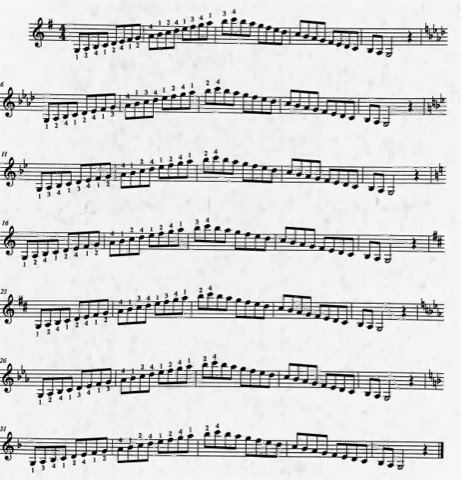Like most classical guitarist of my generation (and many since), I learned scales according to the formula published by Segovia. For those unfamiliar with this method, he establishes unique fingerings for each key, with little overlap, and uses different shifting strategies ascending from the ones he uses descending. Looking back, it is obvious to me this was a dismal method for learning and studying scales. I spent more hours than I care to admit playing those scales, over and over and over. There are better ways. Much better ways. I'll outline here the method I teach my students. It improves on Segovia's method in several important areas, each of which I'll describe in detail.
Another issue with a-m-i scales that needs to be acknowledged is the tendency for the tone to vary more widely from finger to finger. For me, I have to pay attention that the a finger does not sound brighter than the i finger. This is a natural result of the physiology of the hand: the fingers approach the string from slightly different angles. If this effect can be corrected and compensated for, then the technique becomes an invaluable additional resource for scale playing.
So, in conclusion, I feel strongly that scale playing is essential, even indispensable. But the method handed-down to us by Segovia needs to be retired and scales need to be approached in a new way. The method outlined above is enormously effective and fulfills several worthy goals: playing in one key everywhere on the neck, playing in all keys in one place on the neck, offering a predictable, repeatable, consistent right hand fingering with i-m alternation, and fitting perfectly with a-m-i alternation as well.
All instrumentalists practice scales. Just take a walk around the practice rooms of any conservatory and listen. Many guitarists feel scale playing is a noisome burden and ignore this work. But it is foundational in many ways, both musical and technical. And the work is more fun when the patterns involved are consistent. As a bonus, you will greatly deepen your fretboard knowledge with every repetition.
First, let me freely admit I didn't "make this up"--the method I recommend is widely used, in some ways anyway, by electric guitarists. But I didn't come to it through consulting electric guitar methods; I came to it in a more organic way, through trial and error and the application of simple logic.
The basic idea is to play in patterns of 3 notes/string, no exceptions. It is not important to play from tonic-tonic. Using this formula, you will learn, let's say G major, first starting on F#, then on G, then on A, then on B, etc. Each scale will end on a note dictated by the fingering, the first, on B, the next on C and so on (see below). Some guitarists call this "box style"; you can also think of it as position playing, although there is always a shift up one or two frets, especially at the 2nd string, where the tuning demands it. So another way to describe it is "extended position playing." [I should note that in practice, I encourage playing all the configurations for each key that comfortably fit on the fretboard. So, in this example, you will play G major starting on F#, G, A, B and C. Maybe on D, which ends on high G, but not the one starting on E. A different key will provide an opportunity to play that pattern.]
The first thing you realize with this approach is that you end up knowing the key in question in EVERY position on the neck. The entire fretboard becomes G major equally. You are not hemmed in by the tonic on either end, and there are no shifts (except the little ones mentioned above). Then, when confronted with the need to finger a scale in a concert work, it won't matter where you start; with equal access to the key everywhere, the scale is equally comfortable (and pre-learned) in every position.
Of course, it is possible to shift between different positions. I regard left hand shifting as a seperate technical issue -- one it's not necessary to add to scales, which, after all, present a significant challenge already.
What you notice in these patterns is that there are only three finger configurations, and that they ALWAYS occur in the same sequence. The left hand will play, starting on the tonic:
(tonic) 1--2--4 (the two dashes indicates a skipped fret)
(4th) 1--2--4
(7th) 1-2--4
(3rd) 1-2--4
(6th) 1-3-4
(2nd) 1-3-4
(5th) 1--2--4
This sequence has seven components (one for each note of the scale), and the guitar has only six strings. Therefore in every pattern, one component will be omitted. I like to think of the patterns in terms of which scale degree they begin on: tonic, 2nd, 3rd, or whichever. Each one has a distinct pattern caused by where it begins and thus which fingering component is omitted, and yet they are all, oddly, the same. A result of this fact is that it is easy to memorize them quickly.
I encourage the students, though, to know the note names and scale degree of every note they play, not just rely on pattern memorization. This is critical, as it greatly facilitates sight-reading (and improvisation). But I don't mind if they see the patterns! Music is full of patterns, and recognizing them can make learning and understanding music much quicker and easier.
The other fascinating result of learning scales this way is that it enables you to equally: play in one key everywhere, and just as readily, play in every key in one place. Think of this: a note, say, G, is a component of seven different keys. Not just the tonic of G, but the 7th scale degree of Ab, the 6th of Bb, the 5th of C, the 4th of D, the the 3rd of Eb and the 2nd of F. Starting on 3rd-fret G, you can now play all seven of those scales, without shifting. This is a really valuable skill, one that renders the fretboard remarkably transparent:
I feel the student should be equally facile playing each key, in every position, and also, in one position, play all seven corresponding keys, and do so all up and down the neck. Additionally, they should always know the name of every note they are playing and it's corresponding scale degree.
When I offer this plan I sometimes hear: "what about minor keys?", and "isn't this just playing modes?"
I don't regard minor keys as different than major: G = Em, they are the same notes. If there is a chromatically altered note (a raised leading tone, for instance) then by all means play it! But I don't regard practicing melodic minor and harmonic minor scales as valuable.
As far as modes are concerned, I feel that if you are an improvising musician who thinks in modes, then you already understand that the determining factor in what mode you are playing is what harmony prevails at any given moment. In other words, it's about what the bass player is doing. For instance, play your G major scale, and if the underlying harmony is Cmaj, then it sounds like C Lydian; if the harmony is Bm, then it sounds like B Phrygian. Same notes. And anyway, as a classical guitarist I'm not much concerned with this question, but there it is: the same scale routine sets you up to play in all modes with equal facility, everywhere and anywhere on the fretboard.
RIGHT HAND
Now, to the other reason I like this way of teaching scales: the right hand. The primary stumbling block for most guitarists in the execution of scales is string crossing with the right hand. We stumble over the new string, especially in ascending scales. For now I'll focus on simple i-m alternation, the most common formula for scale playing, and address the a-m-i approach shortly.
With the adoption of a uniform pattern like the one I've outlined above, the right hand ends up playing a predictable and consistent series of crosses. The routine is easily codified and sensible to practice away from the left hand. Given that you are using two fingers to execute a three-note pattern, it follows that each string will start with the opposite finger than the last string. If you play the scale up then back down, you will have five notes on the first string, still an odd number, so the alternation continues uninterrupted. [Slash lines indicate crossing to a new string]:
This routine needs to be well-rehearsed (I recommend doing it separate from the left hand until it is automated) and worked with a metronome for speed:
Once your control over the pattern is established, plug in the left hand and enjoy easy, fast scales in every key.
Once your control over the pattern is established, plug in the left hand and enjoy easy, fast scales in every key.
An increasing number of players are embracing the playing of scales with all the fingers, in the repeatable pattern a-m-i. Applying this formula to three notes-per-string fingerings is both highly efficient and intuitive. You will always start the higher string with the higher finger (a). On the descent, the five-note turnaround on the first string enables a subtle shift of the pattern relative to the strings such that you'll start each new string with the lower finger (i). [Note, if playing in continuous fashion, it is necessary to add one extra m finger to end up as you started]:
The potential for fast execution with this formula is enormous; I recommend every serious student incorporate this method for scales in addition to i-m alternation. There are traps though: playing a three-note pattern with a three-finger sequence can easily yield a bumpy, triplet-sounding execution. To avoid this, it is important to practice against it. That is, to clearly emphasize fours in spite of playing threes. This is not too hard to do. Learn to hear the LARGE three as follows: A-m-i-a-M-i-a-m-I-a-m-i:
Another issue with a-m-i scales that needs to be acknowledged is the tendency for the tone to vary more widely from finger to finger. For me, I have to pay attention that the a finger does not sound brighter than the i finger. This is a natural result of the physiology of the hand: the fingers approach the string from slightly different angles. If this effect can be corrected and compensated for, then the technique becomes an invaluable additional resource for scale playing.
So, in conclusion, I feel strongly that scale playing is essential, even indispensable. But the method handed-down to us by Segovia needs to be retired and scales need to be approached in a new way. The method outlined above is enormously effective and fulfills several worthy goals: playing in one key everywhere on the neck, playing in all keys in one place on the neck, offering a predictable, repeatable, consistent right hand fingering with i-m alternation, and fitting perfectly with a-m-i alternation as well.
All instrumentalists practice scales. Just take a walk around the practice rooms of any conservatory and listen. Many guitarists feel scale playing is a noisome burden and ignore this work. But it is foundational in many ways, both musical and technical. And the work is more fun when the patterns involved are consistent. As a bonus, you will greatly deepen your fretboard knowledge with every repetition.








